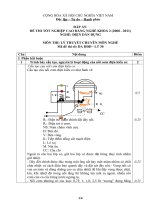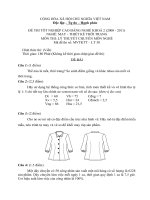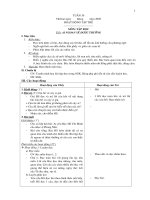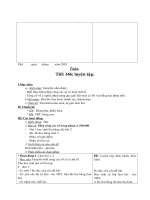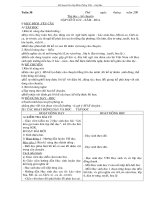PASSAGE 30
Bạn đang xem bản rút gọn của tài liệu. Xem và tải ngay bản đầy đủ của tài liệu tại đây (49.57 KB, 4 trang )
PASSAGE 30
In the Native American Navajo nation which sprawl across four states in the American south-west, the
native language is dying. Most of its speakers are middle-age or elderly. Although many students take
classes in Navajo , the schools are run in English. Street sign, supermarket goods and even their own
newspaper are all in English. Not surprisingly, linguists doubt that any native speakers of Navajo will
remain in a hundred years’ time.
Navajo is far from alone. Half the world’s 6,800 languages are likely to vanish within two generations
– that’s one language lost every ten days. Never before has the planet’s linguistic diversity shrunk at such
a pace. Isolation breeds linguistic diversity as a result, the world is peppered with languages spoken by
only a few people. Only 250 languages have more than a million speakers, and at least 3000 have fewer
than 2500. It is not necessarily these small languages that are about to disappear. Navajo is considered
endangered despite having 150,000 speakers.
What makes a language endangered is not that the number of speakers, but how old they are. If it is
spoken by children it is relatively safe. The critically endangered languages are those that are only spoken
by the elderly, according to Michael Krauss, director of the Alaska Native Language Center, in Fairbanks.
Why do people reject the language of their parents? It begins with a crisis of confidence, when a small
community finds itself alongside a larger, wealthier society, says Nicholas Ostler of Britain’s Foundation
for Endangered Languages, in Bath. “People lose faith in their culture” he says. “When the next
generation reaches their teens, they might not want to be induced into the old tradition.” The change is not
always voluntary. Quite often, governments try to kill off a minority language by banning its use in public
or discouraging its use in school, all to promote national unity. The former US policy of running Indian
reservation in English, for example, effectively put languages such as Navajo on the danger list. But
Salikoko Mufwene, who chairs the Lingustics Department at University of Chicago, argues that the
deadliest weapon is not government policy but economic globalisation. “Native Americans have not lost
pride in their language, but they have had to adapt to socio-economic pressures” he says. “They cannot
refuse to speak English if most commercial activity is in English.”.
However, a growing interest in cultural identity may prevent the direct predictions from coming true.
‘The key to fostering diversity is for people to learn their ancestral tongue, as well as the dominant
language’ says Doug Whalen, founder and president of the Endangered Language Fund in New Haven,
Connecticut. “Most of these will nlt survive without a large degree of bilingualism” he says.
Question 1. It is started in the passage that the number of endangered languages is___________.
A. about 3,200
B. about 6,800
C. At least 3,200
D. Fewer than 2,500
Question 2. The word peppered in paragraph 2 is closest in meaning to___________.
A. randomly separated
B. slowly attacked
C. sparsely distributed
D. Unintentionally controlled
Question 3. According to the passage, endangered languages cannot be saved unless people__________.
A. avoid speaking their dominant language
B. grow interest in cultural identities
C. know more than one language
D. write in their mother tongue
Question 4. Who thinks that a change of language may mean a loss of traditional culture?
A. Doug Whalen
B. Michael Krauss
C. Nicholas Ostler
D. Salikoko Mufwene
Question 5. The word these in paragraph 5 refers to ___________.
A. ancestral tongue
B. dominant language
Page 1
C. growing interest in cultural identity
D. the key to fostering diversity
Question 6. Navajo language is considered being endangered language because_________.
A. it currently has too few speakers
B. it is too spoken by too many elderly and middle-aged speakers
C. it was banned in publicity by the former US policy
D. many young people refuse to learn to speak it
Question 7. Which statement is NOT supported by the information in the passage?
A. A large number of native speakers fail to guarantee the survival of a language.
B. National governments could do more to protect endangered languages.
C. The loss of linguistic diversity in inevitable.
D. Young people often reject the established way to life in their community.
Question 8. What is the main idea of this passage?
A. To describe how diverse languages are in the past.
B. To explain the importance of preserving endangered languages.
C. To explain why more and more languages disappear.
D. To point out that many languages being in danger of extinction.
ĐÁP ÁN
1-A
2-C
3-C
6-A
7-B
8-B
4-D
5-A
LỜI GIẢI CHI TIẾT
Question 1:
Nó được bắt đầu trong đoạn văn rằng số lượng ngôn ngữ có nguy cơ tuyệt chủng là ___________.
A. khoảng 3.200
B. khoảng 6.800
C. Ít nhất 3.200
D. Ít hơn 2.500
=> Dẫn chứng: Only 250 languages have more than a million speakers, and at least 3000 have fewer than
2500.
Dịch: Chỉ 250 ngôn ngữ có hơn một triệu người nói và ít nhất 3000 ngơn ngữ có ít hơn 2500.
Question 2:
Từ peppered trong đoạn 2 gần nhất có nghĩa là ___.
A. tách ngẫu nhiên
C. phân bố thưa thớt
B. tấn cơng từ từ
D. Vơ tình bị kiểm soát
=> Dẫn chứng: Isolation breeds linguistic diversity as a result, the world is peppered with languages
spoken by only a few people.
Dịch: Kết quả là sự đa dạng về ngôn ngữ, kết quả là thế giới bị ảnh hưởng bởi những ngôn ngữ chỉ được
sử dụng bởi một số ít người.
Question 3:
Theo đoạn văn, các ngơn ngữ có nguy cơ tuyệt chủng không thể được giữ lại trừ khi mọi người__.
A. tránh nói ngơn ngữ chính của họ
B. phát triển sự quan tâm đến bản sắc văn hóa
Page 2
C. biết nhiều hơn một ngôn ngữ
D. viết bằng tiếng mẹ đẻ của họ
=> Dẫn chứng: What makes a language endangered is not that the number of speakers, but how old they
are. If it is spoken by children it is relatively safe. The critically endangered languages are those that are
only spoken by the elderly, according to Michael Krauss, director of the Alaska Native Language Center,
in Fairbanks.
Dịch: Điều khiến một ngôn ngữ bị đe dọa không phải là số lượng người nói, mà là họ bao nhiêu tuổi. Nếu
nó được nói bởi trẻ em thì tương đối an tồn. Các ngơn ngữ đang bị đe dọa nghiêm trọng là những ngôn
ngữ chỉ được người già nói, theo Michael Krauss, giám đốc Trung tâm Ngôn ngữ bản địa Alaska, tại
Fairbanks.
Question 4:
Ai nghĩ rằng một sự thay đổi ngơn ngữ có thể có nghĩa là mất văn hóa truyền thống?
A. Doug Whalen
B. Michael Krauss
C. Nicholas Ostler
D. Salikoko Mufwene
=> Dẫn chứng: But Salikoko Mufwene, who chairs the Lingustics Department at University of Chicago,
argues that the deadliest weapon is not government policy but economic globalisation. “Native Americans
have not lost pride in their language, but they have had to adapt to socio-economic pressures” he says.
“They cannot refuse to speak English if most commercial activity is in English.”.
Dịch: Nhưng Salikoko Mufwene, chủ tịch Khoa Ngôn ngữ học tại Đại học Chicago, lập luận rằng vũ khí
nguy hiểm nhất khơng phải là chính sách của chính phủ mà là tồn cầu hóa kinh tế. Người Mỹ bản địa
khơng mất niềm tự hào về ngôn ngữ, nhưng họ phải thích nghi với áp lực kinh tế xã hội. Họ khơng thể từ
chối nói tiếng Anh nếu hầu hết các hoạt động thương mại đều bằng tiếng Anh.
Question 5:
Từ “these” trong đoạn 5 đề cập đến ___________.
A. ngôn ngữ tổ tiên
B. ngơn ngữ chính
C. ngày càng quan tâm đến bản sắc văn hóa
D. chìa khóa để thúc đẩy sự đa dạng
=> The key to fostering diversity is for people to learn their ancestral tongue, as well as the dominant
language’ says Doug Whalen, founder and president of the Endangered Language Fund in New Haven,
Connecticut. “Most of these will nlt survive without a large degree of bilingualism” he says.
Dịch: Chìa khóa để thúc đẩy sự đa dạng là cho mọi người học ngôn ngữ tổ tiên của họ, cũng như ngôn
ngữ thống trị mà ông Doug Whalen, người sáng lập và chủ tịch của Quỹ ngơn ngữ có nguy cơ tuyệt
chủng ở New Haven, Connecticut nói. Hầu hết ngơn ngữ này sẽ sống sót mà khơng cần một mức độ song
ngữ lớn.
Question 6:
Ngơn ngữ Navajo được coi là ngơn ngữ có nguy cơ tuyệt chủng vì.
A. nó hiện có q ít người nói
B. nó được nói bởi quá nhiều người già và người trung niên
C. nó đã bị cấm cơng khai bởi chính sách cũ của Hoa Kỳ
D. nhiều bạn trẻ khơng chịu học nói
Page 3
=> Dẫn chứng: Navajo is considered endangered despite having 150,000 speakers.
Dịch: Navajo được coi là có nguy cơ tuyệt chủng mặc dù có 150.000 người nói.
Question 7:
Phát biểu nào KHƠNG được hỗ trợ bởi thông tin trong đoạn văn?
A. Một số lượng lớn người bản ngữ không đảm bảo sự tồn tại của ngơn ngữ.
B. Chính phủ quốc gia có thể làm nhiều hơn để bảo vệ các ngôn ngữ đang bị đe dọa.
C. Sự mất đa dạng ngôn ngữ là không thể tránh khỏi.
D. Những người trẻ tuổi thường từ chối cách thiết lập cuộc sống trong cộng đồng của họ.
=> Dẫn chứng: Quite often, governments try to kill off a minority language by banning its use in public
or discouraging its use in school, all to promote national unity.
Dịch: Rất thường xuyên, các chính phủ cố gắng tiêu diệt một ngơn ngữ thiểu số bằng cách cấm sử dụng
nó ở nơi cơng cộng hoặc khơng khuyến khích sử dụng nó trong trường học, tất cả để thúc đẩy sự đồn kết
quốc gia.
Question 8:
Ý chính của đoạn văn này là gì?
A. Để mơ tả các ngơn ngữ đa dạng trong quá khứ.
B. Để giải thích tầm quan trọng của việc bảo tồn các ngơn ngữ có nguy cơ tuyệt chủng.
C. Để giải thích tại sao ngày càng nhiều ngơn ngữ biến mất.
D. Để chỉ ra rằng nhiều ngôn ngữ đang có nguy cơ tuyệt chủng
=> The former US policy of running Indian reservation in English, for example, effectively put languages
such as Navajo on the danger list. But Salikoko Mufwene, who chairs the Lingustics Department at
University of Chicago, argues that the deadliest weapon is not government policy but economic
globalisation. “Native Americans have not lost pride in their language, but they have had to adapt to
socio-economic pressures” he says. “They cannot refuse to speak English if most commercial activity is
in English.”.
Dịch: Chẳng hạn, chính sách trước đây của Hoa Kỳ về việc bảo lưu tiếng Ấn Độ bằng tiếng Anh, đã đưa
các ngôn ngữ như Navajo vào danh sách nguy hiểm một cách hiệu quả. Nhưng Salikoko Mufwene, chủ
tịch Khoa Ngôn ngữ học tại Đại học Chicago, lập luận rằng vũ khí nguy hiểm nhất khơng phải là chính
sách của chính phủ mà là tồn cầu hóa kinh tế. Người Mỹ bản địa không mất niềm tự hào về ngôn ngữ,
nhưng họ phải thích nghi với áp lực kinh tế xã hội. Họ khơng thể từ chối nói tiếng Anh nếu hầu hết các
hoạt động thương mại đều bằng tiếng Anh.
Page 4


